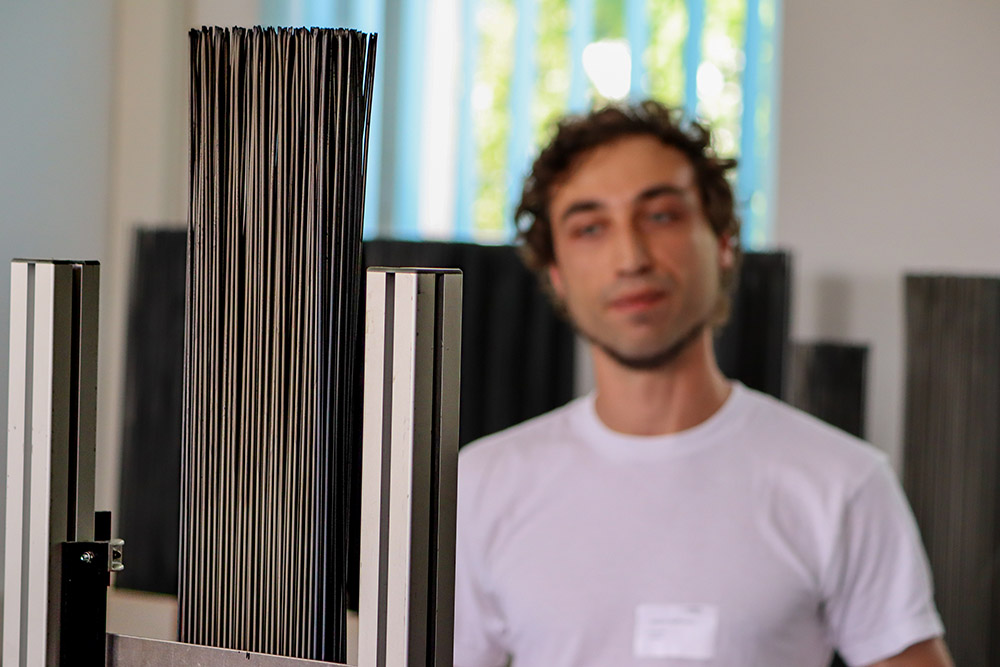Author: Annegret Kolarow | Photos: POXOS®
On-site oxygen for ozonation – first POXOS® oxygen generator delivered for testing in wastewater treatment plant
Wastewater treatment in sewage plants is conventionally carried out in three stages: First, there is mechanical filtration, followed by biological treatment, and finally secondary sedimentation, in which the treated wastewater is separated from the sewage sludge. Increasingly, however, a fourth treatment stage is being used, which is intended in particular to remove micropollutants such as pesticides or detergents from wastewater. In this treatment stage, ozonation takes place. The ozone (O3) reacts with organic compounds, bacteria, viruses and other pollutants in the water and causes their oxidation or destruction.
For an environmentally friendly and more cost-effective alternative to supplying O2 in gas canisters, Fraunhofer IKTS has developed an oxygen generator that produces pure oxygen from air on site at the wastewater treatment plant and makes it available for ozonation. If the generator is operated with sewage gas, a completely CO2-neutral production of oxygen is possible. The IKTS spin-off POXOS® will bring these oxygen modules to market as “POXYGEN® generators” starting in 2024. A major milestone for the spin-off is now the delivery of the first O2 generator from the institute's site in Hermsdorf to the Bitterfeld-Wolfen community sewage treatment plant for testing.
We spoke with POXOS® co-founder Dr. Robert Hoffmann:

POXOS® will go to market next year as a start-up company and offer oxygen generators for wastewater treatment plant operators. What does the first test installation of an O2 generator, which has now recently taken place, mean to you as the founding team?
The first test installation in a wastewater treatment plant is an important milestone for the team, as it allows us to convince people with our system on site for the first time. It is difficult to gain a foothold in the field of wastewater treatment or with wastewater treatment plant operators, so every successful step in this direction is essential. Especially GKW-BiWo, as one of the largest wastewater treatment plants in Germany, is a great partner to start with. We are extremely grateful to have been given this opportunity.
What exactly are the tests planned in Bitterfeld? What findings do you hope to gain?
First of all, the plant is to prove its good manageability and stability through a few weeks of operating phases without being connected to other units. In the further course, the suitability for use in ozonation as well as in revitalization is to be tested step by step. Appropriate test sections will then be designed for this purpose, which will then be validated over the course of several weeks.
Essentially, we hope that we will be able to convince the GKW-BiWo of the POXOS® technology, thus paving the way for further test installations in other wastewater treatment plants and attracting the attention of potential customers and investors.
What are your plans for the near future? How will the collaboration with IKTS proceed?
In the near future, our first gas-fired plant model will be completed and also tested. We will increasingly try to acquire customers and investors and expand our contacts to suppliers and manufacturers as well as to engineering offices, gas producers and potential users. We are targeting all companies and end-users with small to medium O2 requirements. And, of course, the launch of our company will also take place soon. The cooperation with Fraunhofer IKTS will continue to be as close as before. We will cooperate in the use of premises, personnel and know-how, and we will obtain the core element of our generators – the membranes - from IKTS.
